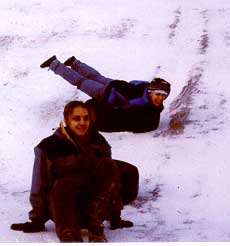
Picture courtesy of http://www.ecomed.net/products/tiretraction.htm
TIRE FRICTIONS
By Marty Woodrow, Wendy Dau and Erin Templeton

Picture courtesy of http://www.ecomed.net/products/tiretraction.htm
TIRE FRICTIONS
By Marty Woodrow, Wendy Dau and Erin Templeton
"Icy conditions on overpasses were blamed for 10 vehicle accidents in the Fairbanks area Tuesday morning."
"Icy roads spur accidents"
"Streets like 'sheets of ice'"
~The Fairbanks Daily News Miner Headlines
Ice is often blamed for automobile accidents, as demonstrated by the above headlines from the Fairbanks Daily News-Miner, and for good reason. Ice can drop traction between a car's tire and the road by 10 percent or more.
The effects of ice on tire traction are not a problem unique to Interior Alaska and many products have been developed to deal with this problem.
We set out to investigate claims of tire manufacturers regarding the safety of different types of tires on icy conditions. We did this by testing the static coefficient of friction on icy roads.
Tire manufacturers have many claims as to the safety and traction of their tires. We based our assumptions on these assertions and common sense. The winter tires were designed to 'bite through snow and stick to ice.' The mud tire was designed to have 'superior off-road performance.' The all weather tires say they have 'superior traction in both rain and snowy conditions,' while also maintaining high fuel economy. The summer tires boasted 'exceptional wet and dry performance' but said nothing about snow, so we thought that they would not perform great on snow and ice. Since there were no descriptions of bald tires, we assumed that they would perform worse than any of the other tires because they have no tread.
Our hypothesis was that the tires that were specifically designed with winter or harsh weather driving in mind would have a greater static coefficient of friction than tires not designed thus.
